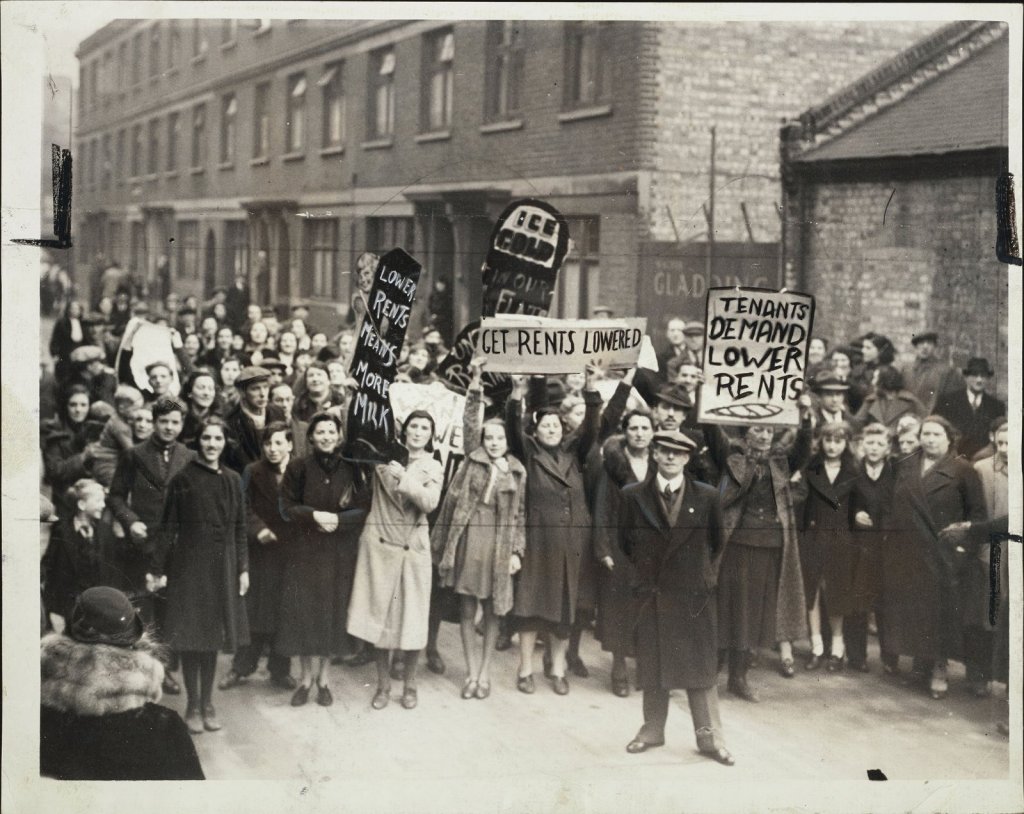‘The idea of living in a neighbourhood…appears virtually to have no connection with any responsibility for its good government in the mind of the average housewife.’[1]
The theme of ‘inspire inclusion’ for Women’s History Month is a welcome opportunity to reassess the portrayal of inter-war working-class women who moved to the suburbs. According to many contemporary accounts, having been ‘given’ the vote they appeared to be clueless about what to do with it and preferred a life of solitary apathy. Dr Stephen Taylor, writing in 1938, called them ‘relatively idle’ and claimed that ‘we have allowed the slum which stunted the body to be replace by a slum which stunts the mind.’[2]
But research into the municipal rent strikes of 1939 demonstrates that this could not be farther from the truth. Middle-class commentators were blinkered by their preconceptions of suburbia and their nostalgic, rose-tinted view of working-class lives in terraces and slums. They mistook being forced to live in proximity with communality, and now regarded the inhabitants of red-brick dormitories as ‘déracinés’ with far too much leisure time on their hands. In fact, working-class women were the backbone of the new communities which had to form on isolated estates on the edge of towns and cities. Nothing had changed over 70 years later, when council estates were regarded as epitomising ‘Broken Britain’, prompting David Cameron to suggest that we should ‘hug a hoodie.’ Now, as then, ‘(a)ll of this squarely (put) the problems of society on the individual,’ in an picture which painted a negative view of working-class women who actually spent their time finding solutions to problems authorities tend to ignore.[3] Working-class women on estates were not homogenous, nor did they share the same background. Some considered themselves ‘respectable’ and their neighbours ‘rough’: they were not natural allies. Yet 1939 saw many of them unite when council-house rents were raised or after differential rebate schemes gave some tenants relief from rent increases and others none. (These were introduced after a savage cut to the housing subsidy, to free up resources for rearmament.) Rent strikes erupted all over England, on council estates from Sunderland to Eastbourne. Female council tenants had for years been ignored by local authorities – when they demanded basic amenities, say, or affordable bus fares – this was the final straw.
Rent is a gendered issue – and what was notable about withholding of rents in 1939 was the participation of women. This was because it was women who had to find the money to pay it and face the rent collector when he came to call. This was a protest of women as consumers for they had no control of the money they received. They considered it to be their struggle, like the anonymous woman who wrote to the press ‘that this is a woman’s fight, as mostly women are in this strike.’ They organised the streets on which they lived, local demonstrations and protests, and the intimidation of rent collectors and bailiffs, and they called meetings. There are few details of the women who withheld their rent and worked tirelessly to be heard but Mrs Caroline Wallace of Kingstanding was both unremarkable and representative of them. Sixty years old, with nine grown-up children, she had been widowed when three were dependants. She had known poverty and relative affluence and spoke for many when she wrote on her homemade poster attached to her house, ‘We are thousands strong.’
This was not what many local authorities had anticipated: they had expected that with the recent influx of ex-slum dwellers among established better-off tenants who had had to prove themselves reliable rent-payers and worthy to look after a new house with an indoor bathroom, tenants would fight over the scant resources, as they had done in Leeds in 1934 when a rent-scheme had been introduced. On the contrary: the strikes’ success and longevity was proof of unity. Some strikes lasted weeks: Willington, Co Durham, lasted more than 31 weeks; Birmingham estates held out for twelve weeks and achieved victory, as did strikers in Amersham.
Yet despite their frequent success and unity, it is as if the strikers were airbrushed out of history. This is not just because of the outbreak of war in September. The strikes were rarely reported in the national press. Depending on the newspaper one read, one could be completely unaware of them. There was no attempt to look at the action through anything but a ‘traditional’ gendered lens: as women, their behaviour was considered differently from men’s. Their labour was hidden behind the municipal painted front door. Theirs were ‘shrill and forceful voices that chanted the refrain, “We Won’t Pay!”’[4] It is difficult to imagine industrial unrest on such a scale receiving so few column inches, or so little attention from historians.
Fiona Lane is a PhD researcher and Associate Lecturer in the Department of History.
[1] Mass Observation, Enquiry, 208.
[2] Stephen Taylor, ‘The Suburban Neurosis’, The Lancet, 26/3/38, 761.
[3] Lisa McKenzie, Getting By: Estates, Class and Culture in Austerity Britain (Bristol, 2015), 11.
[4] Birmingham Mail 7/2/39.
